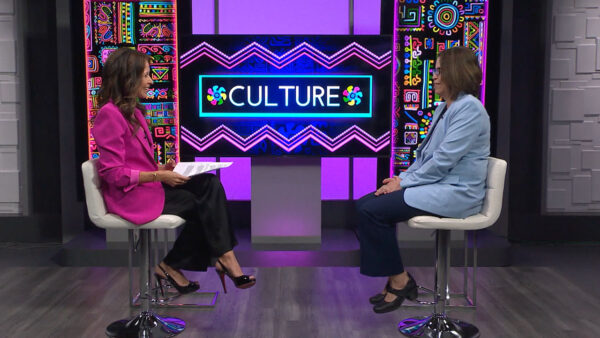Learn about the Latin sound of 99 year old bandleader Rafael “Chapito” Chavarria, whose signature musical style combined popular Mexico City tropical rhythms of the 1940s and 1950s. with American swing and jitterbug. Singer Ray “Gumbi” Salazar and Musical Director for the “Chapito!” documentary and Phoenix College instructor for Liberal Arts and Sciences, Devon Leal Bridgewater discuss the history of Chapito Chavarria and a documentary set to be released about him.
José Cárdenas: Here now with me to talk about the Rafael "Chapito" Chavarria is Ray "Gumbi" Salazar. Ray is a well-known entertainer and vocalist in the early 1950s. That's when he started. Also here is Devon Leal Bridgewater. Devon is the musical director for the upcoming Chapito Chavarria Orchestra Concert at the Musical Instrument Museum. He is also a professor at Phoenix College in the Chicana and Chicano studies department. Gentlemen, thank you both for joining us on "Horizonte." And after that musical introduction, you can see why the Congressman who was our last guest was so excited about getting to this interview and so am I. We should first thank the Chavarria family for providing those magnificent pictures that we saw that capture the music scene in phoenix in the 50's and 60's and Ray I think people are going to find it hard to believe that you were a vocalist in the early 1950s but that's because you were a kid at the time.
Ray "Gumbi" Salazar: I was five years old. I wasn't a vocalist then. I was a dancer; they used to call me "El Rey del Mambo." I became their floor show in 1953 at the Calderon Ballroom.
José Cárdenas: One of the famous ballrooms in Phoenix at the time. And did you perform with Chapito?
Ray "Gumbi" Salazar: Like I said I was the floor show so every time they played, I was there entertaining the people as a dancer but Luis Estrada would pull me and up showed me how to play congas how to play mariachi.
José Cárdenas: And you later became a well-known musician in your own right and singer, you still are.
Ray "Gumbi" Salazar: Thank you very much, thank you. Yeah and it was because of -- looking at Luis Estrada I was little and I always had the talent of music thank God but seeing him live --
José Cárdenas: He was one of the big names, too. So Devon, you're an academic but you're also a musician and you got involved in this project. How so?
Devon Leal Bridgewater: Well, as the musical director and the film maker putting this all together, we've been -- we've been very lucky in that we've been able to find musicians who used to work with Chapito. I actually worked with him before I went off to college, but the trumpet player as well and the tenor saxophonist. So that was very interesting, and part of the project was getting the guys back that had actually worked in the band with Chapito. And we had been doing interviews with Chapito down at the Post 41.
José Cárdenas: He's about to turn 100.
Devon Leal Bridgewater: He's 99 now and he's going to turn 100 in April. The Musical Instrument Museum has been gracious enough to provide the facility and they're going to be doing an exhibit showing, you know, his original music manuscripts.
José Cárdenas: What was distinctive about him was his style that he imported in a sense from Mexico City; describe that and the mixing with what was popular in the United States at the time.
Devon Leal Bridgewater: Well his career is very interesting because the style of music that he was really driven by and influenced by was a group called Sonora Santanera. They were a very popular group in Mexico City, kind of what we call "tropical" and it was elegant dance music, big band music, big Latin orchestrations. And so this was, you know, his desire was to keep that music going and to harken back to those days in Mexico and he also played a lot of American jazz music and Swing music. So we're all going to incorporate all that music into this concert.
José Cárdenas: And what was the mood in Phoenix at the time when you were a little bit older but the clubs were very popular, people went to them a lot and kind of hung out, Congressman one of them as he mentioned off-camera. Describe that for us.
Ray "Gumbi" Salazar: After Chapito or --
José Cárdenas: During the time period, yeah.
Ray "Gumbi" Salazar: El Calderon, the street was dirt and it was called "Hanchaw," 16th street and Hanchaw. And so it was the first Latin club, the Latin ballroom for Hispanics to go and dance and let their hair down. But the thing is that Chapito, La Sonora Santanera would come and play there.
José Cárdenas: From Mexico.
Ray "Gumbi" Salazar: Yeah from Mexico and people would go crazy and no electrified it was all acoustic; beautiful. But what Chapito did was to put the tropical music, there was no cumbia, there was no mix tapes. Back then it was all cha-cha, mambo, charanga, that kind of music, tropical music.
José Cárdenas: Beautiful, elegant music.
Ray "Gumbi" Salazar: Yeah and Luis Estrada; I tell people that Frank Sinatra was in the English field being the crooner and Luis Estrada in the Spanish field --
José Cárdenas: Devon, we're almost out of time. But two things quickly. One, the documentary will talk not only about Chapito's music but the discrimination that he faced and before we run out of time, tell us about what's coming up at the mem.
Devon Leal Bridgewater: Well, we've done some filming at the post and Chapito was one of the veterans that was instrumental in getting Post 41 going. And, you know, because the veterans came back and they didn't have a place to congregate and that's where some of his best gigs were.
José Cárdenas: He experienced discrimination while he was in the service.
Devon Leal Bridgewater: Yes, in the service. He talks about some bad experiences, namely in Kansas.
José Cárdenas: And the documentary's going to cover that.
Devon Leal Bridgewater: And we're going to cover all of those issues.
José Cárdenas: And we're almost out of time. Tell me what we're going to see at the mem.
Devon Leal Bridgewater: Well that's on September 15th, so that's a Sunday, and we begin at 2 o'clock, we'll have two 45-50 minute sets and we're going to kind of go on a historical, chronological order and Gumbi is going to be our male singer and we have Ruby Fena is our female vocalist and she's going to be singing. The first set will have some instrumental numbers; the second set will be predominantly vocal numbers and a lot of recognizable tunes for the people.
José Cárdenas: It will be a lot of fun and the cost for the tickets?
Devon Leal Bridgewater: $32.50 and $42.50. And you can go to www.Chapitodocumentary.com. We're also looking for if the families have pictures, it would be great to have old movies from the weddings, the many, many weddings that Chapito played at over the years.
José Cárdenas: Hopefully the show they're watching and they'll send them in. Thank you both for talking about this legend on the Arizona music scene.
Ray "Gumbi" Salazar:Singer; Devon Leal Bridgewater:Professor, Phoenix College























